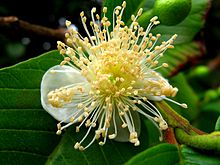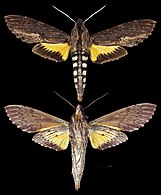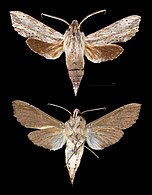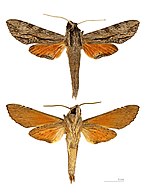Erinnyis
Erinnyis Hübner, 1819[1] è un genere di lepidotteri appartenente alla famiglia Sphingidae, diffuso in America Settentrionale, Centrale e Meridionale.
Descrizione
[modifica | modifica wikitesto]Adulto
[modifica | modifica wikitesto]Nel capo, i palpi labiali si proiettano leggermente al di là della fronte; il processo formante la gena è triangolare e lungo, mentre il pilifer ha una lunghezza ancora maggiore, sebbene di poco.[2]
Nelle zampe, i tarsi mediani presentano un pettine rudimentale; gli speroni delle tibie posteriori sono sviluppati, ma di lunghezze diverse.[2]
In generale la pagina superiore dell'ala anteriore è di colore scuro, con una macchia chiara a livello della giunzione toracica, e spesso una seconda macchia chiara allungata a metà del margine posteriore; sempre nell'ala anteriore, il termen è più o meno dentato. L'ala posteriore appare di regola gialla o arancione nella parte prossimale, e più scura sul margine esterno.[2][3][4]
Le antenne hanno di norma una lunghezza pari a circa metà del margine costale, e sono uncinate alle estremità. Il torace è scuro, grigio o rosso brunastro; l'addome è scuro, con bande trasversali chiare, più o meno marcate a seconda della specie.[2]
Larva
[modifica | modifica wikitesto]Il bruco è verdastro, cilindrico, leggermente appiattito, con geometrie bianche o rossastre, in qualche modo simili a Pseudosphinx e Isognathus.[2] È presente il cornetto caudale sull'ottavo urotergite.[4]
-
Larva di Erinnyis ello
Pupa
[modifica | modifica wikitesto]Le crisalidi appaiono nere, lucide, con macchie di colore arancione spento. Il cremaster non è molto sviluppato; si rinvengono entro bozzoli posti a scarsa profondità nella lettiera del sottobosco.[2][4]
Biologia
[modifica | modifica wikitesto]Durante l'accoppiamento, le femmine richiamano i maschi grazie ad un feromone rilasciato da una ghiandola, posta all'estremità addominale.[4]
Periodo di volo
[modifica | modifica wikitesto]Nelle zone tropicali dell'areale, gli adulti sono rinvenibili durante tutto l'anno, mentre a latitudini più temperate, le specie sono bi- o trivoltine.[4]








Alimentazione
[modifica | modifica wikitesto]Gli adulti suggono il nettare di fiori di varie specie, tra cui Saponaria officinalis L. (Saponaria, Caryophyllaceae) e Asystasia gangetica (L.) T.Anderson (Acanthaceae).[4]
I bruchi attaccano le foglie di membri di diverse famiglie, tra cui:
- Allamanda spp. L. (Apocynaceae)
- Blepharodon mucronatum (Schltdl.) Decne. (Apocynaceae)
- Carica papaya L. (Papaia o Papaya) (Caricaceae)
- Cnidoscolus angustidens Torr. (Euphorbiaceae)
- Cynanchum palustre (Pursh) A. Heller (Apocynaceae)
- Cynanchum racemosum (Jacq.) Jacq. (Talayote) (Apocynaceae)
- Dipholis salicifolia (L.) A.DC. (Sapotaceae)
- Euphorbia heterophylla L. (Euphorbiaceae)
- Euphorbia pulcherrima Willd. ex Klotzsch (Poinsettia o Stella di Natale) (Euphorbiaceae)
- Euphorbia viminea Hook.f. (Euphorbiaceae)
- Forsteronia spicata (Jacq.) G. Mey. (Apocynaceae)
- Hippomane mancinella L. (Euphorbiaceae)
- Jatropha spp. L. (Euphorbiaceae)
- Macroscepis obovata Kunth (Apocynaceae)
- Manihot esculenta Crantz (Cassava o Manioca) (Euphorbiaceae)
- Manilkara bahamensis (Baker) H. J. Lam & A. Meeuse (Sapotaceae)
- Morrenia odorata (Hook. & Arn.) Lindl. (Apocynaceae)
- Philibertia heterophylla spp. (Engelm. ex Torr.) Jeps. (Apocynaceae)
- Philibertia viminalis (Sw.) A. Gray (Apocynaceae)
- Psidium guajava L. (Guava) (Myrtaceae)
- Rauvolfia ligustrina Willd. ex Roem. & Schult (Apocynaceae)
- Rauvolfia tetraphylla L. (Apocynaceae)
- Sarcostemma angustissimum (Andersson) R.W. Holm (Apocynaceae)
- Sideroxylon celastrinum (Kunth) T.D.Penn (Sapotaceae)
- Stemmadenia obovata (Hook. & Arn.) K.Schum (Apocynaceae)
Distribuzione e habitat
[modifica | modifica wikitesto]L'areale di questo genere è prevalentemente di tipo neotropicale, comprendendo Argentina, Belize, Bolivia, Brasile, Colombia, Costa Rica, Cuba, Dominica, Ecuador, Galápagos, Giamaica, Guatemala, Guiana Francese, Guyana, Haiti, Honduras, Messico, Nicaragua, Panama, Paraguay, Perù, Piccole Antille, Repubblica Dominicana, Stati Uniti meridionali, Suriname, Uruguay, Venezuela.[2][3][4]
L'habitat è rappresentato da foreste tropicali e sub-tropicali, dal livello del mare fino a medie altitudini.[4]
Tassonomia
[modifica | modifica wikitesto]Specie
[modifica | modifica wikitesto]Il genere comprende undici specie:[2][3][4][5]
- Erinnyis alope (Drury, 1773) - Illust. Nat. Hist. Exot. Insects 1 : 58, pl. 27, f. 1 - Locus typicus: Giamaica[6]
- Erinnyis crameri (Schaus, 1898) - Ent. News. 9 (6) : 136 - Locus typicus: America Tropicale, Florida[7]
- Erinnyis ello (Linnaeus, 1758) - Syst. Nat. (Edn 10) 1 : 491 - Locus typicus: India (sic!) (specie tipo, Sphinx ello)[8]
- Erinnyis guttularis (Walker, 1856) - List Spec. Lepid. Insects Colln Br. Mus. 8: 227 - Locus typicus: Santo Domingo[9]
- Erinnyis impunctata Rothschild & Jordan, 1903 - Novit. zool.. 9 (suppl.): 365 - Locus typicus: Venezuela, Aroa[10]
- Erinnyis lassauxii (Boisduval, 1859) - Bull. Soc. ent. Fr. (3) 7 : 157 - Locus typicus: Buenos Aires, Argentina[11]
- Erinnyis obscura (Fabricius, 1775) - Syst. Ent.: 538 - Locus typicus: America[12]
- Erinnyis oenotrus (Cramer, 1780) - Uitl. Kapellen 4 (25-26a): pl. 301, f. C, (index) 251 - Locus typicus: Suriname[13]
- Erinnyis pallida Grote, 1865 - Proc. ent. Soc. Philad.. 5: 78 - Locus typicus: Cuba[14]
- Erinnyis stheno (Geyer, 1829) - Samml. exot. Schmett.. 3: pl. [37] - Locus typicus: Piccole Antille, S.ta Crux (?)[15]
- Erinnyis yucatana (Druce, 1888) - Ann. Mag. nat. Hist.. (6) 2: 238 - Locus typicus: Messico, Yucatán[16]
Sinonimi
[modifica | modifica wikitesto]Sono stati riportati tre sinonimi:[3][5]
- Anceryx Walker, 1856 - List Spec. Lepid. Insects Colln Br. Mus. 8: 222 - Specie tipo: Sphinx alope Drury, 1770 (Sinonimo eterotipico)[9]
- Anceryx Lucas, 1857 - in Sagra, Hist. fis. pol. nat. Isla Cuba (2) 7 : 707 - Specie tipo: Sphinx alope Drury, 1770 (Sinonimo eterotipico)[17]
- Dilophonota Burmeister, 1855 - Abh. naturf. Ges. Halle 3: 69 - Specie tipo: Sphinx ello Linnaeus, 1758 (Sinonimo eterotipico)
Alcune specie
[modifica | modifica wikitesto]-
Erinnyis alope
-
Erinnyis crameri
-
Erinnyis guttularis
-
Erinnyis impunctata
-
Erinnyis lassauxi
-
Erinnyis yucatana
Note
[modifica | modifica wikitesto]- ^ Jacob Hübner, Verzeichniss bekannter Schmettlinge, 1816-[1826] (1):1-3], 4-16 (1816), (2): 17-32 (1819), (3): 33-48 (1819), (4): 49-64 (1819), (5): 65-80 (1819), (6): 81-96 (1819), (7): 97-112 (1819), (8): 113-128 (1819), (9): 129-144 (1819), (10): 145-160 (1819), (11): 161-176 (1819), (12): 177-192 (1820), (13): 193-208 (1820), (14): 209-224 (1821), (15): 225-240 (1821), (16): 241-256 (1821), (17): 257-272 (1823), (18): 273-288 (1823), (19): 289-304 (1823), (20): 305-320 (1825), (21): 321-336 (1825), (22): 337-352 (1825), (23-27): 353-431 ([1825]), Augsburg, Bey dem Verfasser zu Finden, 1819.
- ^ a b c d e f g h Bernard D'Abrera, Sphingidae Mundi. Hawk Moths of the World. Based on a Checklist by Alan Hayes and the collection he curated in the British Museum (Natural History), 1ª ed., Faringdon, Oxon., SN7 7DR United Kingdom, E.W. Classey Ltd., 1986, pp. 98-99, ISBN 0860960226.
- ^ a b c d CATE Creating a Taxonomic e-Science, su cate-sphingidae.org. URL consultato il 14 luglio 2011 (archiviato dall'url originale il 20 settembre 2011).
- ^ a b c d e f g h i Silkmoths, su silkmoths.bizland.com. URL consultato il 14 luglio 2011.
- ^ a b Funet, su ftp.funet.fi. URL consultato il 14 luglio 2011.
- ^ Dru Drury, Illustrations of natural history; wherein are exhibited ... Illust. Nat. Hist. Exot. Insects 1 : 1-130, pl. 1-50 (1770), (1773), 1773.
- ^ William Schaus, Note on American Sphingidae. - II Ent. News. 9 (6) : 134-136, 1898.
- ^ Carl von Linné, Systema Naturae per Regna Tria Naturae, Secundum Clases, Ordines, Genera, Species, cum Characteribus, Differentiis, Symonymis, Locis. Tomis I. 10th Edition Syst. Nat. (Edn 10) 1 : 1-338, : 339-824, 1758.
- ^ a b Francis Walker, List of the Specimens of Lepidopterous Insects in the Collection of the British Museum List Spec. Lepid. Insects Colln Br. Mus. 8: 1-271, 1856.
- ^ Rothschild & Jordan, A revision of the Lepidopterous family Sphingidae Novit. Zool. 9 (Suppl.) : 1-813 815-972, pl. 1-67, 1903.
- ^ Jean Baptiste Alphonse Dechauffour de Boisduval, Bull. Soc. ent. Fr. (3) 7 : cliv-clvii,[154-157],clvii-clviii,[157-158], 1859.
- ^ Johan Christian Fabricius, Systema Entomologiae, sistens Insectorum Classes, Ordines, Genera, Species, Adiectis Synonymis, Locis, Descriptionibus, Observationibus. Syst. Ent.: 832pp, 1775.
- ^ Pieter Cramer, Uitlandsche Kapellen (Papillons exotiques) Uitl. Kapellen 4 (25-26a): 1-28, pl. 289-304, 1780.
- ^ Augustus Radcliffe Grote, Notes on Cuban Sphingidae Proc. Ent. Soc. Philad. 5 : 33-84, 1865.
- ^ Carl Geyer, Sammlung exotischer Schmetterlinge, Vol. 3 ([1827] - [1838]) in Hübner, Samml. exot. Schmett. 3 : pl. [9], [11], [21], [26-27], [32], [43], [45] (1827), : pl. [7], [13], [35], [42] (1828), : pl. [20], [22], [37-38] (1829), : pl. [17], [24], [41], [49] (1830), : pl. [30] (1831), : pl. [25], [28], [31], [44], [50-51] (1832), : pl. [5-6], [14-16], [29], [48], [52] (1833), : pl. [1], [12], [18] (1834), : pl. [2-4], [10], [19], [23], [39], [46] (1835), : pl. [40] (1836-1837), : pl. [8], [33-34], [36], [47], [53] (1838), 1829.
- ^ Herbert Druce, in Godman & Salvin, 1881; Biologia Centrali-Americana; or Contributions to the Knowledge of the Fauna of Mexico and Central America. Zoology. Lepidoptera. Heterocera Biol. centr.-amer., Lep. Heterocera 1: 1-490, 3: pl. 1-101, 1881.
- ^ Hippolyte Lucas, Historia física política y natural de la Isla de Cuba. (Lepidópteros) in Sagra, Hist. fis. pol. nat. Isla Cuba (2) 7 : 474-750, pl. 14-17 (French Edition) (1857), : 202-313, pl. 14-17 (1857), 1857.
Bibliografia
[modifica | modifica wikitesto]- Boisduval, 1870 - Considerations sur des Lépidoptères envoyés du Guatemala à M. de l'Orza Considérations Lépid. Guatemala: 100pp
- Boisduval, [1875] - Histoire Naturelle des Insectes. Species Général des Lépidoptéres Hétérocéres. Tome Premier. Sphingides, Sésiides, Castnides Hist. nat. Ins., Spec. gén. Lépid. Hétérocères, 1 : 1-568, pl. 1-11
- Butler, 1881 - Notes on some North American Lepidoptera Papilio 1 (7): 103-106, (8): 128-132, (9): 168-171, (11): 220-223
- (EN) Capinera, J. L. (Ed.), Encyclopedia of Entomology, 4 voll., 2nd Ed., Dordrecht, Springer Science+Business Media B.V., 2008, pp. lxiii + 4346, ISBN 978-1-4020-6242-1, LCCN 2008930112, OCLC 837039413.
- Cramer, [1777] - Uitlandsche Kapellen (Papillons exotiques) Uitl. Kapellen 2 (9-16): 1-152, pl. 97-192 (1777)
- Edwards H., 1882 - New species of Heterocera Papilio 2 (1) : 9-15
- Grote, 1867 - Remarks on the Sphingidae of Cuba, and Description of a New Species of Ambulyx from Brazil Ann. Lyc. nat. Hist. N.Y. 8 : 195-207
- Grote & Robinson, 1865 - A synonymical catalogue of North American Sphingidae, with notes and descriptions Proc. Ent. Soc. Philad. 5 : 149-193, pl. 1-3
- Grote & Robinson, 1868 - Notes on the North American Lepidoptera in the British Museum and described by Mr. Francis Walker Trans. amer. ent
- Hemming Francis, 1937 - HÜBNER, A bibliographical and systematic account of the entomological works of Jacob Hübner and of the supplements thereto by Carl Geyer, Gottfried Franz von Frölich and Gottlieb August Wilhelm Herrich-Schäffer, Vol. 1 & 2
- Hodges Ronald W., 1971 - The Moths of America North of Mexico; Fascicle 21; SPHINGOIDEA
- Kitching & Cadiou, 2000 - Hawkmoths of the World; An annotated and illustrated revisionary checklist (Lepidoptera: Sphingidae). 256 pp.; Comstock Publishing Associates - Ithaca; ISBN 978-0-8014-3734-2
- (EN) Kükenthal, W. (Ed.), Handbuch der Zoologie / Handbook of Zoology, Band 4: Arthropoda - 2. Hälfte: Insecta - Lepidoptera, moths and butterflies, a cura di Kristensen, N. P., collana Handbuch der Zoologie, Fischer, M. (Scientific Editor), Teilband/Part 35: Volume 1: Evolution, systematics, and biogeography, Berlino, New York, Walter de Gruyter, 1999 [1998], pp. x + 491, ISBN 978-3-11-015704-8, OCLC 174380917.
- Landman Wijbren, 2001 - The Complete Encyclopedia of Moths. 272 pp.; Grange Books; ISBN 1-84013-409-7
- Lewis H.L., 1974 - Butterflies of the World; ISBN 0-245-52097-X
- Linnaeus, 1771 - Mantissa Plantarum altera Generum editionis Vi & Specierum editionis II Mantissa Plant. 2: -,[iv], 142-510, + Regni Animalis Appendix 511-552
- Opler Paul, Pavulaan Harry, Stanford Ray, Pogue Michael - Butterflies and Moths of North America; Mountain Prairie Information Node
- Opler & Warren, 2003 - Butterflies of North America. 2. Scientific Names List for Butterfly Species of North America, north of Mexico.
- (EN) Scoble, M. J., The Lepidoptera: Form, Function and Diversity, seconda edizione, London, Oxford University Press & Natural History Museum, 2011 [1992], pp. xi, 404, ISBN 978-0-19-854952-9, LCCN 92004297, OCLC 25282932.
- Sepp, [1848] - Natuurlijke Historie van Surinaamsche Vlinders, naar het leven geteekend. Papillons de Surinam dessinés d'après nature Surinaam. Vlinders 1 (1): 1-16, pl. 1-4 ([1829]), 1 (2): 17-24, pl. 5-8 ([1829]), 1 (3): 25-32, pl. 9-12 ([1830]), 1 (4): 33-40, pl. 13-16 ([1830]), 1 (5): 41-48, pl. 17-20 ([1832]), 1 (6): 49-56, pl. 21-24 ([1832-1840]), 1 (7): 57-64, pl. 25-28 ([1832-1840]), 1 (8): 65-72, pl. 29-32 ([1840]), 1 (9): 73-80, pl. 33-36 ([1841]), 1 (10): 81-88, pl. 37-40 ([1841]), 1 (11): 89-96, pl. 41-44 ([1842]), 1 (12): 97-104, pl. 45-48 ([1842]), 1 (13): i-viii, 105-108, pl. 49-50 ([1843]), 2 (13): 109-112, pl. 51-52 ([1843]), 2 (14): 113-120, pl. 53-56 ([1843]), 2 (15): 121-128, pl. 57-60 ([1844]), 2 (16): 129-136, pl. 61-64 ([1844]), 2 (17): 137-144, pl. 65-68 ([1845]), 2 (18): 145-152, pl. 69-72 ([1845]), 2 (19): 169-176, pl. 73-76 ([1845]), 2 (20): 177-184, pl. 77-80 ([1846]), 2 (21): 185-192, pl. 81-84 ([1847]), 2 (22): 193-200, pl. 85-88 ([1846]), 2 (23): 201-208, pl. 89-92 ([1847]), 2 (24): 209-216, pl. 93-96 ([1847]), 2 (25): i-iv, 217-224, pl. 97-100 ([1847]) , 3 (26): 225-232, pl. 101-104 ([1848]), 3 (27): 233-240, pl. 105-108 ([1848]), 3 (28): 241-248, pl. 109-112 ([1848]), 3 (29): 249-256, pl. 113-116 ([1849]), 3 (30): 257-264, pl. 117-120 ([1849]), 3 (31): 265-272, pl. 121-124 ([1850]), 3 (32): 273-280, pl. 125-128 ([1850]), 3 (33): 281-288, pl. 129-132 ([1851]), 3 (34): 289-296, pl. 133-136 ([1851]), 3 (35): 297-304, pl. 137-140 ([1851]), 3 (36): 305-312, pl. 141-144 ([1851]), 3 (37): 313-320, pl. 145-148 ([1852]), 3 (38): i-viii, 321-328, pl. 149-152 ([1852])
- (EN) Stehr, F. W. (Ed.), Immature Insects, 2 volumi, seconda edizione, Dubuque, Iowa, Kendall/Hunt Pub. Co., 1991 [1987], pp. ix, 754, ISBN 978-0-8403-3702-3, LCCN 85081922, OCLC 13784377.
- Swainson, 1823 - Zoological illustrations, or original figures and descriptions of new, rare, or interesting animals, selected chiefly from the classes of ornithology, entomology, and conchology, and arranged on the principles of Cuvier and other modern zoologists Zool. Illustr. (1) 1: pl. 1-18 (1820), 1: pl. 19-66 (1821), 2: pl. 67-83 (1821), 2: pl. 84-119 (1822), 3: pl. 120-134 (1822), 3: pl. 135-182 (1823)
- Tuttle James P., 2007 - The Hawkmoths of North America, A Natural History Study of the Sphingidae of the United States and Canada. The Wedge Entomological Research Foundation, Washington DC; ISBN 978-0-9796633-0-7.
Voci correlate
[modifica | modifica wikitesto]Altri progetti
[modifica | modifica wikitesto] Wikimedia Commons contiene immagini o altri file su Erinnyis
Wikimedia Commons contiene immagini o altri file su Erinnyis Wikispecies contiene informazioni su Erinnyis
Wikispecies contiene informazioni su Erinnyis
Collegamenti esterni
[modifica | modifica wikitesto]- (EN) CATE Creating a Taxonomic eScience, su cate-sphingidae.org. URL consultato il 14 luglio 2011 (archiviato dall'url originale il 20 settembre 2011).
- (EN) Funet.fi, su ftp.funet.fi. URL consultato il 14 luglio 2011.
- (EN) ITIS Catalogue of Life 2011 [collegamento interrotto], su catalogueoflife.org. URL consultato il 15 febbraio 2012.
- (EN) Lepidoptera Barcode of Life, su lepbarcoding.org. URL consultato il 14 luglio 2011 (archiviato dall'url originale il 4 marzo 2016).
- (EN) National History Museum [collegamento interrotto], su nhm.ac.uk. URL consultato il 14 luglio 2011.
- (EN) Silkmoths, su silkmoths.bizland.com. URL consultato il 14 luglio 2011.
- (EN) Tree of Life Web Project, su tolweb.org. URL consultato il 14 luglio 2011.











